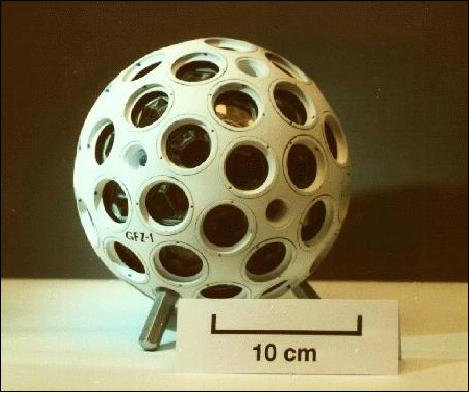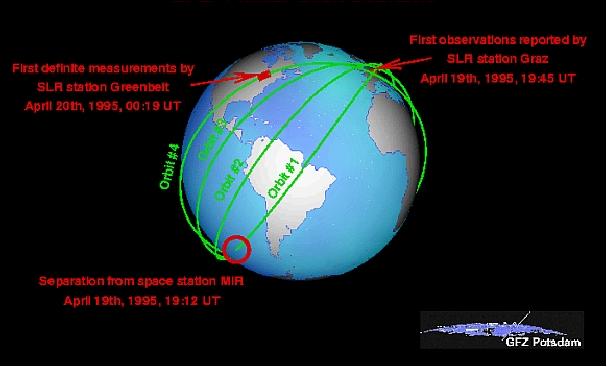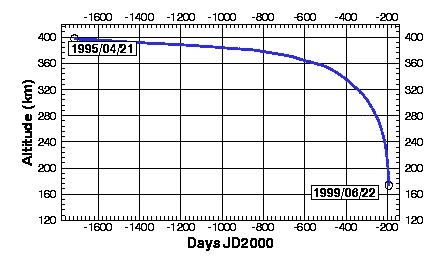GFZ-1 (GeoForschungsZentrum-1 Geodesy Satellite)
EO
Mission complete
Gravity instruments
GFZ
Quick facts
Overview
| Mission type | EO |
| Agency | GFZ |
| Mission status | Mission complete |
| Launch date | 19 Apr 1995 |
| End of life date | 23 Jul 1999 |
| Instrument type | Gravity instruments |
| CEOS EO Handbook | See GFZ-1 (GeoForschungsZentrum-1 Geodesy Satellite) summary |
GFZ-1 (GeoForschungsZentrum-1 Geodesy Satellite)
GFZ-1 is a German geodesy mission of GFZ Potsdam, a passive microsatellite with the objective to improve our knowledge of the Earth's gravity field (to determine variations in the rotational characteristics of the Earth and to measurement changes in the Earth's gravity field).

Spacecraft
On May 31, 1994, the GFZ Potsdam awarded the prime contract to Kayser-Threde GmbH of Munich for the design and construction of the satellite as well as for the arrangement of a MIR launch by RKK Energia (RKK was the operator of the MIR station). GFZ-1 has a mass of 20.630 kg and a diameter of 215 mm. The small GFZ-1 satellite is of spherical shape made from brass whose outer surface is covered with 60 laser (corner cube) retroreflectors. The low Earth orbits of GFZ-1 was selected for high-accuracy determination of Earth's near gravity field. 1) 2) 3) 4)
RRA (RetroReflector Array) characteristics: The GFZ-1 RRA consists of 60 corner cubes and has a center of mass correction of 58 mm ± 2 mm. These retroreflectors are quartz prisms placed in special holders that are recessed into the satellite's body. External metallic surfaces are covered with white paint for thermal control purposes and to facilitate visual observation in space.

Launch
The launch of GFZ-1 to the MIR station took place on April 9, 1995 on the Progress M-27 service flight from Baikonur, Kazakhstan. The deployment/insertion of GFZ-1 into its own orbit took place on April 19, 1995.
Orbit: Near-circular orbit, eccentricity < 0.01, altitude 383 km 394 km (initial orbit of MIR) to about 150 km (end of mission), inclination=51.6º, period of 92.3 minutes, estimated mission life of > 3 years. The low-altitude and slowly decaying orbit was chosen for high-sensitivity response in the Earth's gravity field. As such, GFZ-1 was the lowest orbiting geodynamics satellite in its class.

Sponsor | GFZ Potsdam, Germany |
Expected life | 5 years |
Primary applications: | Time varying gravity field |
OSPAR ID | 8601795 |
Launch date | April 19, 1995 |
RRA (RetroReflector Array) diameter | 21.5 cm |
Reflectors | 60 corner cubes |
Orbit | Circular (deployed from the MIR Space Station) |
Satellite mass | 20.630 kg |
Mission Status
• GFZ-1 reentered the atmosphere on June 23, 1999 after more than 4 years in orbit (over 24,000 orbits). The spacecraft disintegrated in the upper atmosphere. The last track of GFZ-1 was probably registered by the TIRA (Tracking and Imaging Radar) station at Effelsberg, Germany, of FGAN (Forschungsgesellschaft für Angewandte Naturwissenschaften) on June 23, 1999 around 00:56 UT (reentry began at 01:21 UT). NORAD confirmed the reentry of GFZ-1. 6) 7) 8) 9)
• The precise orbit of GFZ-1 was determined by laser ranging (cm range accuracy). GFZ operated its own SLR (Satellite Laser Ranging) station in Potsdam and supported a further station at Santiago de Cuba (in cooperation with Centro Nacional de Investigaciones Sismologicas). - The international SLR community, comprising a worldwide network of SLR stations, was invited to track GFZ-1. During four years and 64 days in space, 5,402 passes of GFZ-1 were observed by 33 stations of the global SLR network. The tracking data of GFZ-1 are being used for gravity field analysis by the international geodetic community.

• GFZ-1 has demonstrated the possibilities and difficulties of tracking such low targets with state-of-the-art SLR systems. In view of the results showing the presently unique contribution of GFZ-1 data in the area of gravity field determination from such LEO observations, together with a great deal of invaluable procedural experiences induced by this mission, the mission is internationally being recognized as highly successful.
References
1) Information provided by Ch. Reigber and R. König of GFZ Potsdam
2) R. König, P. Schwintzer, A. Bode, C. Reigber, “GFZ-1: a small laser satellite mission for gravity field model improvement,” Geophysical Research Letters, Vol. 23, Issue 22, 1996, pp. 3143-3146, DOI: 10.1029/96GL02574
3) R. König, Z. Chen, C. Reigber, P. Schwintzer, “Improvement in global gravity field recovery using GFZ-1 satellite laser tracking data,” Journal of Geodesy, Vol. 73, No 8, Sept. 1999, pp. 398-406
4) http://ilrs.gsfc.nasa.gov/satellite_missions/list_of_satellites/gfz1_general.html
5) “Geo Research Satellite GFZ-1,” GFZ [web source no longer available]
6) W. Schulte, “Microsatellite GFZ-1 terminates investigation of the Earth's gravity field,” Kayser Threde, June 30, 1999, URL: http://www.kayser-threde.de/en/press/news_detail.php?id=27
7) Note. The TIRA antenna dish has a diameter of 34 m offering high rotational rates of 24º/s and accelerations of 6º/s2. The TIRA system features an L-band tracking radar and a Ku-band imaging radar. TIRA is located in a radom with a diameter of 49 m. A main objective of TIRA is to search for satellites and for orbital debris.
8) Z. Chen, R. König, ”The GFZ/D-PAF orbit Prediction System with Emphasis on the Low Flyer GFZ-1”, Proceedings. of the 10th International Workshop on Laser Ranging Instrumentation, Shanghai Observatory, Chinese Academy of Sciences, Shanghai, China, Nov. 11-15, 1996, pp. 489-496
9) R. König, A. Bode, Z. Chen, C. Reigber, “Surface forces parameterization of GFZ-1 orbits and gravity field recovery,” Advances in Space Research, Vol. 19, Issue 11, 1997, pp. 1677-1680
The information compiled and edited in this article was provided by Herbert J. Kramer from his documentation of: ”Observation of the Earth and Its Environment: Survey of Missions and Sensors” (Springer Verlag) as well as many other sources after the publication of the 4th edition in 2002. - Comments and corrections to this article are always welcome for further updates (eoportal@symbios.space).